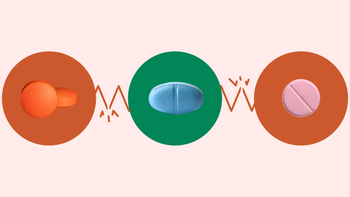
What Is Sciatica, and How Is It Treated?
Key takeaways:
Sciatica is a common type of lower back pain that travels down into the buttocks, thigh, lower leg, or foot. It’s usually on one side of your body.
Symptoms of sciatica are caused by compression or irritation of the sciatic nerve.
Over-the-counter pain medications, heat or ice packs, massage, and light exercise can help treat sciatica and improve pain for most people.
Table of contents

Back pain is very common. Nearly 80% of people will have some form of back pain at least once in their lives. Sciatica is a specific kind of back pain that starts in the lower back and travels down the leg. In severe cases, it can impact your quality of life. Fortunately, there are sciatica treatments that can help treat your symptoms and offer you some relief.
Let’s take a closer look at what sciatica is, how to know you have it, and how you can treat it.
What is sciatica?
Sciatica is a type of back and leg pain caused by compression or irritation of the sciatic nerve. The sciatic nerve is the largest nerve in your body. At about 2 cm wide, it has the width of a penny. Your sciatic nerve starts at the lower end of your spinal cord, in the small of your back and travels down your leg. The nerve splits into your tibial and common peroneal nerves, which provide feeling and movement to your lower leg. Anything that compresses your sciatic nerve as it exits the lower spine or courses down into your leg can cause sciatica.
Search and compare options
Treatments for sciatica target the cause or focus on treating the pain or inflammation.
Medications for sciatica
There are many different medications that treat sciatica. Let’s review the common types of sciatica treatment below.
Nonsteroidal anti-inflammatory drugs
Nonsteroidal anti-inflammatory drugs (NSAIDs) like ibuprofen (Advil, Motrin) and naproxen (Aleve) are often the go-to choice for managing sciatica. These medications work by reducing inflammation around the sciatic nerve. They’re available over the counter, but prescription-strength versions are also used when symptoms are more severe.
Acetaminophen (Tylenol)
Acetaminophen is an over-the-counter (OTC) pain medication that can relieve mild to moderate pain from sciatica. It doesn’t have a lot of side effects so it can be a good alternative for people who can’t take NSAIDs because of stomach or kidney issues. Acetaminophen doesn’t reduce inflammation like NSAIDs do though. So while it can help with your pain, it won’t actually help your sciatica heal.
Oral corticosteroids
A short course of steroids like prednisone or methylprednisolone can be prescribed to calm inflammation in your lower back. Corticosteroids have lots of side effects though, so it’s best not to use them for the long term. They’re most often used when the pain isn’t improving with other treatments or when your healthcare team can’t prescribe you other medications for medical reasons.
Muscle relaxants
If muscle spasms are also a factor in your pain, medications like cyclobenzaprine (Flexeril) or methocarbamol (Robaxin) can help. These medications work by relaxing tense muscles, which can reduce pressure on the sciatic nerve. Drowsiness is a common side effect, so muscle relaxants are usually recommended at night. You should also avoid alcohol when using any muscle relaxer.
Sciatica stretches: Moving your body can help relieve sciatica. These stretches can help relieve your sciatica pain.
Home remedies for sciatica: Learn more about how to manage sciatica at home, from heating or cold packs to gentle stretches.
Sleeping on your side with sciatica may offer more relief. Find out how to get a good night’s sleep when you have low back pain.
Neuropathic pain medications
Neuropathic medications are a group of medications that specifically treat pain caused by your nerves. Because sciatica is a condition affecting your sciatic nerve, it makes neuropathic pain medications a reasonable choice.
Medications like gabapentin (Neurontin) and pregabalin (Lyrica) can help treat sciatica. They may work for the burning, tingling, or shooting sensations of sciatica. These medications work by calming overactive nerve signals. They are often used when pain becomes chronic or persistent.
Tricyclic antidepressants
Tricyclic antidepressants (TCAs) like amitriptyline are sometimes usedto manage nerve pain, including sciatica. These older antidepressants affect the way the brain and spinal cord process pain signals. These medications aren’t commonly a first choice. But they may be helpful when other options haven’t provided enough relief.
Opioids
Opioid pain medications are sometimes used in the short term for severe pain that interferes with daily activities or sleep. However, due to the risks of dependence, constipation, and other side effects, they’re typically not used long term. A healthcare professional might consider them when other treatments haven’t worked.
Topical treatments
Topical products like lidocaine patches or capsaicin cream may provide some localized relief. They aren’t always effective for deep nerve pain, though, and are often used in addition to other treatments rather than alone. These medications generally don’t interact with other medications and have few side effects. This can make them helpful if your healthcare team prescribes you several medications.
Physical therapy
Physical therapy is one of the most effective treatments for sciatica. A licensed physical therapist can guide you through exercises that help sciatica by:
Strengthening your core and back muscles
Improving flexibility
Reducing pressure on the sciatic nerve
The goal isn’t just to relieve pain, but also to correct any underlying issues that may be causing your pain. Over time, physical therapy can help improve mobility and prevent future flare-ups.
Many people start to notice improvement within a few weeks. A structured home exercise program can help you maintain long-term results. Physical therapy is often recommended alongside medications and lifestyle strategies as part of a comprehensive care plan.
Steroid injections
Epidural steroid injections may be an option when sciatica pain is severe or doesn’t improve with other therapies. This treatment works by placing a corticosteroid directly into the space around the irritated nerve. This helps to lower inflammation.
Relief from steroid injections can be significant, but it varies from person to person. Some people feel better for weeks or months, while other people may need repeat injections. Steroid injections are generally safe, but you shouldn’t get them more than a few times per year.
Surgery
Surgery is typically a last resort for sciatica and should be considered only when other treatments haven’t worked. The most common surgical procedure is called a discectomy. This is when a surgeon removes part of the disc in your back that’s pressing on your sciatic nerve. Another surgical procedure that can be performed for sciatica is a laminectomy. A laminectomy widens the spinal canal to help relieve pressure on the sciatic nerve.
While surgery can have a high success rate, it’s important to weigh the pros and cons carefully. Surgery for sciatica can have a long recovery period and involves risks like infection and bleeding. And most people with sciatica improve without surgery anyway. Surgery is recommended only when absolutely necessary.
Massage
Massage therapy may help relieve muscle tension. It can also improve blood flow, reduce stress, and promote relaxation — all of which can contribute to pain relief. Massage won’t fix structural issues like a herniated disc. But it may be helpful when combined with other treatments, especially during flare-ups.
Some people with sciatica find that certain therapies provide noticeable relief. These therapies include:
Deep tissue massage
Trigger point therapy
Myofascial release
Just be sure to work with a licensed massage therapist who has experience with nerve-related conditions. You will also want to avoid overly aggressive techniques that could worsen your symptoms.
Acupuncture
Acupuncture is a technique that involves inserting thin needles into specific points on the body. The science is still evolving on why it works. But some studies suggest acupuncture helps to reduce sciatica pain by promoting the release of endorphins. These are the body’s natural painkillers.
Acupuncture is generally considered safe when performed by a licensed practitioner. It might not work for everyone. But acupuncture can be worth trying if other treatments haven’t provided you with enough relief, or you’re looking for other options.
OTC and home remedies
Sciatica can usually be treated at home with OTC medications, especially when it’s mild. Common choices include NSAIDs and acetaminophen. Other home remedies to help ease inflammation and muscle tension include:
Applying ice
Doing gentle stretching
Staying active to avoid prolonged sitting or bed rest
Using supportive cushions while sitting
Maintaining good posture
Doing low-impact exercise, like walking or swimming
While these strategies aren’t a cure, they can be surprisingly effective when used consistently. And they can also support recovery and prevent recurrence of sciatica pain.
Frequently asked questions
There are many different kinds of back pain, but sciatica symptoms are very specific. Sciatica isn’t limited to back pain. It causes pain, numbness, tingling, or weakness in the buttocks, thigh, calf, or foot, too. These symptoms usually occur only on one side of your body.
Certain risk factors may make sciatica more likely for some people. These common risk factors include:
Middle age
Being diagnosed as overweight or having obesity
Smoking
Having a previous back injury or arthritis of the spine
Frequent back straining, such as from a physically demanding job
Psychological stress or depression
Pregnancy
Sciatica is caused by pressure on the sciatic nerve. This can happen because of a herniated disc, spinal stenosis, or an injury. Other causes include arthritis, pregnancy, or muscle irritation. In very rare cases, tumors or infections may be involved. Sometimes, the exact cause isn’t known.
Sciatica usually improves within a few weeks to a couple of months. In some cases, symptoms may come and go or take longer to fully resolve — particularly if there’s an underlying issue like a herniated disc. If your symptoms are worsening or not improving, it’s important to follow up with a healthcare professional.
There’s no single “best” vitamin for sciatica, but certain nutrients can support nerve health. B vitamins, like B1 (thiamine), B6 (pyridoxine), and B12 (cobalamin), are important for maintaining healthy nerves. However, vitamins alone aren’t likely to resolve sciatica. Always talk with a healthcare professional before starting supplements for sciatica.
The bottom line
Sciatica is a specific kind of back pain that’s caused by pressure on the sciatic nerve. Sciatica can be quite uncomfortable, but it’s usually only temporary. There are many treatment options for sciatica including medications, physical therapy, and surgery. But most people get better with nonsurgical treatment and time.
Why trust our experts?



References
Britannica. (2025). Sciatic nerve.
Chou, R., et al. (2007). Medications for acute and chronic low back pain: A review of the evidence for an American Pain Society/American College of Physicians clinical practice guideline. Annals of Internal Medicine.
Chou, R., et al. (2017). Nonpharmacologic therapies for low back pain: A systematic review for an American College of Physicians clinical practice guideline. Annals of Internal Medicine.
Chou, R., et al. (2017). Systemic pharmacologic therapies for low back pain: A systematic review for an American College of Physicians clinical practice guideline. Annals of Internal Medicine.
Delitto, A., et al. (2012). Low back pain. Journal of Orthopaedic and Sports Physical Therapy.
Derry, S., et al. (2014). Topical lidocaine for neuropathic pain in adults. Cochrane Database of Systematic Reviews.
Fritz, J. M., et al. (2021). Physical therapy referral from primary care for acute back pain with sciatica : A randomized controlled trial. Annals of Internal Medicine.
Furlan, A. D., et al. (2015). Massage for low-back pain. Cochrane Database of Systematic Reviews.
Goldberg, H., et al. (2015). Oral steroids for acute radiculopathy due to a herniated lumbar disk: A randomized clinical trial. JAMA.
Ko, S., et al. (2016). The effectiveness of oral corticosteroids for management of lumbar radiating pain: Randomized, controlled trial study. Clinics in Orthopedic Surgery.
Martell, B. A., et al. (2007). Systematic review: Opioid treatment for chronic back pain: Prevalence, efficacy, and association with addiction. Annals of Internal Medicine.
Mason, L., et al. (2004). Systematic review of topical capsaicin for the treatment of chronic pain. The BMJ.
Mathieson, S., et al. (2017). Trial of pregabalin for acute and chronic sciatica. The New England Journal of Medicine.
Mauro, G. L., et al. (2000). Vitamin B12 in low back pain: A randomised, double-blind, placebo-controlled study. European Review for Medical and Pharmacological Sciences.
MedlinePlus. (2024). Sciatica.
MedlinePlus. (2024). Sciatic nerve.
MedlinePlus. (2025). Back pain.
Oliveira, C. B., et al. (2018). Clinical practice guidelines for the management of non-specific low back pain in primary care: An updated overview. European Spine Society.
Oliveira, C. B., et al. (2020). Epidural corticosteroid injections for lumbosacral radicular pain. Cochrane Database of Systematic Reviews.
Parreira, P., et al. (2018). Risk factors for low back pain and sciatica: An umbrella review. The Spine Journal.
Peul, W. C., et al. (2007). Surgery versus prolonged conservative treatment for sciatica. The New England Journal of Medicine.
Qaseem, A., et al. (2017). Noninvasive treatments for acute, subacute, and chronic low back pain: A clinical practice guideline from the American College of Physicians. Annals of Internal Medicine.
Qin, Z., et al. (2015). Effectiveness of acupuncture for treating sciatica: A systematic review and meta-analysis. Evidence-Based Complementary and Alternative Medicine.
Quraishi, N. A. (2011). Transforaminal injection of corticosteroids for lumbar radiculopathy: Systematic review and meta-analysis. European Spine Journal.
Robertson, K., et al. (2016). Pregabalin and gabapentin for the treatment of sciatica. Journal of Clinical Neuroscience.
Saarto, T., et al. (2007). Antidepressants for neuropathic pain. Cochrane Database of Systematic Reviews.
van Tulder, M. W., et al. (2003). Muscle relaxants for non-specific low back pain. Cochrane Database of Systematic Reviews.
Williams, C. M., et al. (2014). Efficacy of paracetamol for acute low-back pain: A double-blind, randomised controlled trial. The Lancet.

























